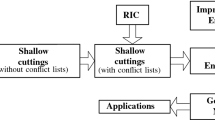Abstract
The paper presents the sequential and the parallel algorithm for solving the nearest-neighbor problem in the plane, based on the generalized Voronoi diagram construction. The applications of the problem are found in the areas of networking, communications, distributed systems, computer modeling and information retrieval. The input for the problem is the set of circular sites S with varying radii, the query point p and the metric (Minkowski or power) according to which the site, neighboring the query point, is to be reported. The sequential algorithm takes O(n) time to build the data structure and O(log n) time for each query. The parallel algorithm requires O(log n log) preprocessing time and O(log) query time on EREW PRAM architecture with n/log n processors. The IDG/NNM software was developed for an experimental study of the problem. The experimental results demonstrate that the Voronoi diagram method outperforms the k − d tree method for all tested input configurations. The tests were conducted on large data sets, comprising thousands of generators.
Similar content being viewed by others
References
P. Aggarwal and P. Raghawan. Deferred data structures for the nearest-neighbor problem. Information Processing Letters, 40:119–122, 1991.
J. L. Bentley. k–d trees for semidynamic point sets. In Proceedings of the 6th Annual ACM Symposium on Computational Geometry, pp. 187–197, 1990.
S. Berchtold, B. Ertl, D. Keirn, H. P. Kriegel, and T. Seidel. Fast nearest neighbor search in highdimensional space. In Proceedings of the 14th International Conference on Data Engineering. Orlando, Fla., 1998.
O. Devillers, M. Golin, K. Kedem, and S. Schirra. Queries on Voronoi diagrams of moving points. Computational Geometry-Theory and Applications, 6:315–327, 1996.
J. Friedman, J. Bentley, and R. Finkel. An algorithm for finding best matches in logarithmic expected time. ACM Transactions on Mathematical Software, 3:209–226, 1977.
D. Gavrilov and O. Vinogradov. A cluster in granular systems as a topologically variable structure. In Proceedings of 1997 ASCE Symposium on Mechanics of Deformation and Flow of Particulate Materials, pp. 299–307, Evanston, Ill., 1997.
M. Gavrilova. Proximity and applications in general metrics. Ph.D. thesis, Department of Computer Science, University of Calgary, Canada, 1999.
M. Gavrilova, J. Rokne, O. Vinogradov, and D. Gavrilov. Collision detection algorithms in simulation of granular materials. 1999 ASME Mechanics and Materials Conference, pp. 283–284, 1999.
T. Graf and K. Hinrichs. A plane-sweep algorithm for the all-nearest-neighbors problem for a set of convex planar objects. In Proceedings of the 3rd Workshop on Algorithmic Data Structure, Lecture Notes in Computer Science, vol. 709, pp. 349–360. Springer-Verlag, Berlin, 1993.
V. A. Luchnikov, N. N. Medvedev, V. P. Voloshin, and A. Geiger. Simulation of transport and diffusion of the Voronoi network. In Scientific Computing in Chemical Engineering. Springer-Verlag, Berlin, 1999.
N. N. Medvedev. Voronoi-Delaunay Method for Non-crystalline Structures. SB Russian Academy of Science, Novosibirsk, 2000 (in Russian).
M. Murphy and S. Skiena. A study of data structures for orthogonal range and nearest neighbor queries in high dimensional spaces. CSE 523/524 master's project, Department of Computer Science, SUNYSB, 1996.
A. Okabe, B. Boots, and K. Sugihara. Spatial Tessellations: Concepts and Applications of Voronoi Diagrams. John Wiley & Sons, Chichester, England, 1992.
B. Schaudt and R. Drysdale. Higher-dimensional Voronoi diagrams for convex distance functions. In Proceedings of the 4th Canadian Conference on Computational Geometry, pp. 274–279, 1992.
W. Shinoda and S. Okazaki. A Voronoi analysis of lipid area fluctuation in a bilayer. Journal of Chemical Physics V, 109:1517–1521, 1998.
C. Xu and F. Lau. Load Balancing in Parallel Computers-Theory and Practice. Kluwer Academic Publishers, Norwell, Mass., 1997.
B. Shirazi, A. Hurson, and K. Kavi. Scheduling and Load Balancing in Parallel and Distributed Systems. IEEE Computer Society Press, 1995.
A. Papadopoulos and Y. Manolopoulo. Parallel processing of nearest-neighbor queries in declustered spatial data. In Proceedings of the 4th ACM Workshop on Advances in Geographic Information Systems, pp. 35–43, 1996.
J. C. Hardwick. Implementation and evaluation of an efficient parallel Delaunay triangulation algorithm. In Proceedings of the 9th Annual Symposium on Parallel Algorithm and Architectures, pp. 22–25, 1997.
I. Kolingerov and J. Kohout. Pessimistic threaded Delaunay triangulation. GraphiCon'2000, pp. 76–83, 2000.
N. M. Amato and E. A. Ramos. On computing Voronoi diagrams by divide-prune-and-Conquer. In Proceedings of the 12th Annual ACM Symposium on Computational Geometry, pp. 166–175, 1996.
S. Akl and K. Lyon. Parallel Computational Geometry. Prentice Hall, Englewood Cliffs, NJ, 1993.
S. G. Akl and S. D. Bruda. Improving a solution's quality through parallel processing. The Journal of Supercomputing, 19:221–233, 2001.
Author information
Authors and Affiliations
Rights and permissions
About this article
Cite this article
Gavrilova, M.L. On a Nearest-Neighbor Problem Under Minkowski and Power Metrics for Large Data Sets. The Journal of Supercomputing 22, 87–98 (2002). https://doi.org/10.1023/A:1014310721543
Issue Date:
DOI: https://doi.org/10.1023/A:1014310721543




